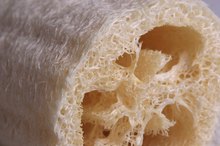What Causes Pimples on Legs?
Pimples on your legs can dampen your enthusiasm for donning clothes that expose your otherwise gorgeous gams. Whether on your legs or elsewhere on your body, pimples arise from the hair follicles of the skin. In addition hair-producing cells, hair follicles contain skin oil from sebaceous glands that empty into them. Pimples develop when hair follicles become blocked, infected or inflamed. While acne is the most common causes of facial pimples, those on the legs usually arise due to other skin conditions.
Keratosis Pilaris
A persistent or recurring pimple-like rash on your legs is most likely due to a condition called keratosis pilaris (KP). Though you might not have heard of it, KP is very common. According to a Fall 2012 article in the "International Journal of Trichology," KP affects approximately 40 percent of adults 5. It appears as tiny, painless pimples due to plugging of the hair follicles by a protein called keratin. The rash resembles goose bumps and is sometimes mildly itchy. KP commonly appears on the fronts of the thighs and might extend to the lower legs. The upper arms are also frequently involved.
While many people dislike the appearance of KP, it is medically harmless. Exfoliating the affected skin and using a moisturizer after bathing or showering can help control mild KP. If these remedies are not effective and the rash bothers you, see you doctor to discuss other treatment options.
- A persistent or recurring pimple-like rash on your legs is most likely due to a condition called keratosis pilaris (KP).
Folliculitis
Acne on Legs & Butt
Learn More
Folliculitis refers to inflammation of the hair follicles, which causes reddish pimples that are often tender and contain pus. Infection, blockage or physical irritation of the hair follicles can trigger folliculitis. The condition can occur anywhere there are hair follicles, including the legs. Shaving or waxing your legs, or using a depilatory can predispose you to folliculitis due to infection or physical irritation of the hair follicles, or both. Blockage might also be to blame if you use an oil-based moisturizer on your legs, which can clog the hair follicles.
Treatment for folliculitis varies, depending on the underlying cause. For example, common treatments for bacterial folliculitis include washing with antibacterial soap or applying a topical antibiotic. Oral antimicrobial medication might be needed for more severe cases of infectious folliculitis. Recurring folliculitis associated with hair removal might respond to using a different method, after allowing the hair to regrow.
- Folliculitis refers to inflammation of the hair follicles, which causes reddish pimples that are often tender and contain pus.
- Shaving or waxing your legs, or using a depilatory can predispose you to folliculitis due to infection or physical irritation of the hair follicles, or both.
Other Causes
Most leg pimples are caused by either KP or folliculitis, but there are less common causes. For example, genital herpes can cause a painful, pimple-like rash on the thighs. The pimples evolve into fluid-filled blisters, then ulcers. A pimple-like rash might also occur due to some types of bug or insect bites. Additionally, certain prescription medications can cause an acne-like rash, which might involve any body surface with hair follicles. Other skin conditions might also present with an acne-like rash on the legs.
- Most leg pimples are caused by either KP or folliculitis, but there are less common causes.
- A pimple-like rash might also occur due to some types of bug or insect bites.
Little Red Bumps on My Legs After Wearing Jeans
Learn More
See your doctor for any unexplained pimple-like rash on your legs to get an accurate diagnosis and appropriate treatment recommendations. Seek medical care as soon as possible if you experience any warning signs or symptoms, including: -- itchiness, burning, tingling or pain at the site of the rash -- spreading rash, redness or swelling -- lumps beneath the skin -- drainage of pus -- fever or chills
Reviewed and revised by: Tina M. St. John
Related Articles
References
- The Biology of the Skin; Ruth K. Freinkel and David T. Woodley
- Goodheart's Photoguide to Common Skin Disorders: Diagnosis and Management, 3rd Edition; Herbert P. Goodheart
- Dermatology; Jean L. Bolognia, et al.
- VisualDx: Essential Adult Dermatology; Noah Craft, M.D., et al.
- International Journal of Trichology: Keratosis Pilaris Revisited: Is It More Than Just a Follicular Keratosis?
- Teraki Y, Nakamura K. Rubbing skin with nylon towels as a major cause of pseudomonas folliculitis in a Japanese population. J Dermatol. 2015 Jan;42(1):81-3. doi:10.1111/1346-8138.12712
- Nagoba BS, Selkar SP, Wadher BJ, Gandhi RC. Acetic acid treatment of pseudomonal wound infections--a review. J Infect Public Health. 2013 Dec;6(6):410-5. doi:10.1016/j.jiph.2013.05.005
- U.S. Centers for Disease Control and Prevention. Facts about hot tub rash.
- American Osteopathic College of Dermatology. Hot Tub Folliculitis.
- Hlavsa MC, Cikesh BL, Roberts VA, et al. Outbreaks associated with treated recreational water - united states, 2000-2014. MMWR Morb Mortal Wkly Rep. 2018 May 18;67(19):547-551. doi:10.15585/mmwr.mm6719a3
- Lutz JK, Lee J. Prevalence and antimicrobial-resistance of Pseudomonas aeruginosa in swimming pools and hot tubs. Int J Environ Res Public Health. 2011 Feb;8(2):554-64. doi:10.3390/ijerph8020554
- MedlinePlus. Hot Tub Folliculitis. U.S. National Library of Medicine. Updated October 14, 2018.
Writer Bio
Shannon Marks started her journalism career in 1994. She was a reporter at the "Beachcomber" in Rehoboth Beach, Del., and contributed to "Philadelphia Weekly." Marks also served as a research editor, reporter and contributing writer at lifestyle, travel and entertainment magazines in New York City. She holds a Bachelor of Arts in literature from Temple University.









